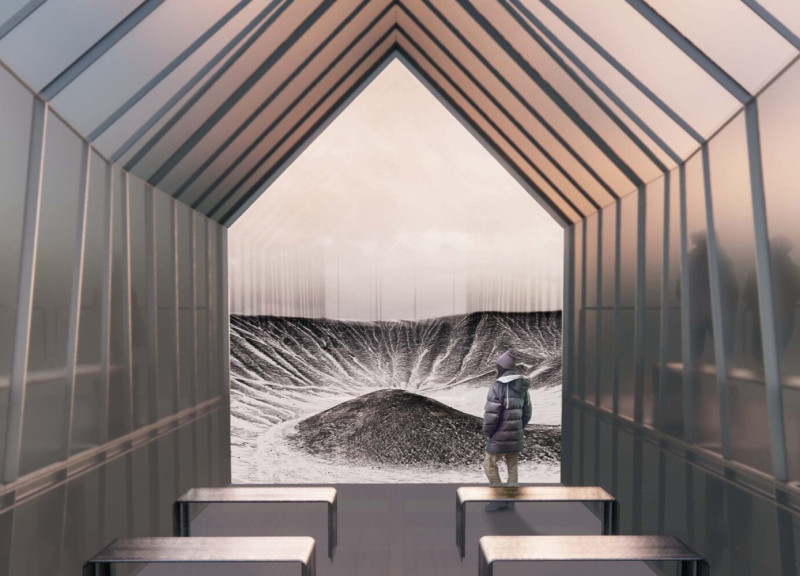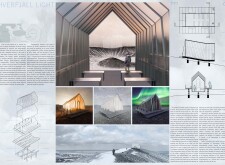5 key facts about this project
The overarching concept of HVERFJALL LIGHT revolves around transparency and openness. The architectural design is characterized by extensive use of glass, which creates a seamless boundary between inside and outside. This not only maximizes natural light within the space but also provides unobstructed views of the surroundings, allowing the breathtaking scenery to serve as an integral part of the visitor experience. The structure is designed to invite people in and encourage them to appreciate the beauty of Hverfjall and its dynamic landscape, particularly highlighting phenomena such as the aurora borealis.
A noticeable aspect of the design is its elongated, narrow form, which prioritizes sightlines towards the crater and its surrounding vistas. This deliberate orientation creates a series of internal spaces that cater to both communal gatherings and solitary contemplation. Within the structure, seating arrangements are intentionally organized to promote social interaction while also allowing individuals to quietly absorb the environment. The design eschews traditional barriers, favoring an approach that emphasizes accessibility and encourages exploration of the space.
Materiality plays a crucial role in the overall effectiveness of the architectural design. HVERFJALL LIGHT employs a combination of glass, wood, and steel, each chosen for its properties that enhance the project’s connection to its context. The glass walls provide not only transparency but also a means to experience the changing qualities of light throughout the day. In contrast, the use of wood adds warmth and a tactile element that enriches the space's ambiance while connecting to traditional Icelandic architecture. Steel is strategically utilized for structural support, offering durability while maintaining a lightweight appearance that does not detract from the landscape.
The design’s unique approaches are significant in defining its character. One notable aspect is the innovative incorporation of natural light, which has been carefully considered to influence the internal environment over time. The angle of the glass elements has been designed to create shifting shadows and reflections, allowing visitors to engage with the space in varying ways as light conditions change. This responsiveness not only enhances aesthetic appeal but also enriches the sensory experience of visiting the structure.
Another important element is the environmental sustainability embedded within the architectural framework. The project emphasizes passive heating and cooling strategies that leverage the natural topography of the site, aiming to minimize its ecological footprint. The selection of materials also reflects a commitment to sustainability, ensuring that the design respects the delicate balance of the Icelandic ecosystem.
HVERFJALL LIGHT thus serves as a compelling example of how architecture can respond to its environment while providing functional spaces for human activity. By emphasizing connection, transparency, and sustainability, the project invites visitors to engage deeply with the beauty that surrounds them. Those interested in exploring architectural plans, sections, and various design ideas related to this project are encouraged to seek out further presentations that provide a comprehensive overview of its intricate details and planning processes. Engaging with these resources can offer valuable insights into how thoughtful design can enhance the experience of natural landscapes.























